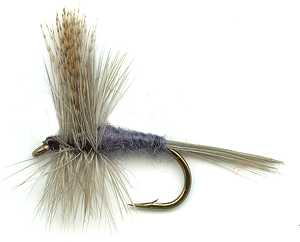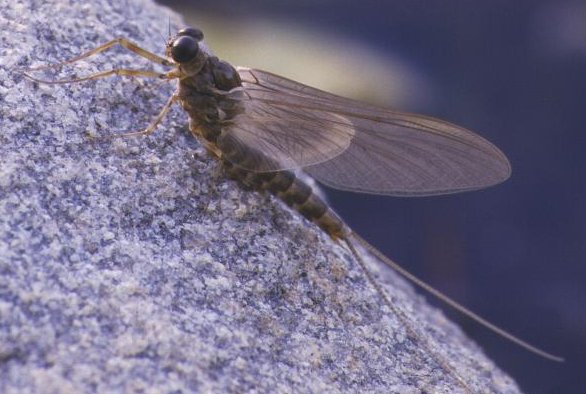Dark Hendrickson Dry Fly
The Dark Hendrickson dry flies are good general dark body mayfly dun imitation patterns. Choose the hook size to match your local hatch. Back in 1915 Albert Everett Hendrickson of Scarsdale, NY, USA wrote to Roy Steenrod, about tying a fly to match the dark North American up-winged dun mayfly Ephemerella subvaria.

DRY FLY PATTERNS. Hook size 12 14 16 18 20 24 - $US each
Roy Steenrod lived in Liberty, NY and fished the Beaver Kill, Esopus, Nerversink and Willowemoc rivers. Albert was invited to accompany Roy on some fishing trips. One day in 1916 whilst fishing on the Beaver Kill river below the junction pool at Roscoe, a hatch of flies came on. They had never seen the fish rise so freely for any fly as they did for this hatch. Roy caught one of the insects and put it in his fly box and tied a fly to match. They tried it out after lunch. They took fish after fish with this new fly pattern day after day.
Two days after the fly was first tied the matter was brought up as to what to call this killer pattern. Roy named it after his new fishing friend and it has been known as the Hendrickson ever since. (Please note that there is a dispute over who originally tied them as some credit Art Flick though I favor the above story) These flies are used all over the USA but is not well known outside North America. This is a shame as I have found them both to be a very productive fly in British and European waters for imitating iron blue duns.
The Hendrickson is a great attracter pattern. It can be about as deadly as the all year around Adams Dry Fly. An attracter pattern is designed to stimulate a predatory fish's aggression. They do not try to imitate the fish's food. They just provoke a predatory attack response. Although these flies were designed to imitate a certain insect they can be used in areas and at times of the year when that fly is not present. Try a Hendrickson when all logic says it shouldn't work. Use it as an attractor, something different that will catch a trout's hungry eye. It is a fly that has saved the day for me many a time when the fish were not rising for anything I cast to them. This is a pattern that every fly box should not be without.

Use the Dark Hendrickson dry fly to imitate dark bodied mayfly duns.
The trout fly fisherman must understand that there are two winged forms of the Mayfly. As it emerges from its subsurface nymphal stage in its life cycle the Mayfly turns into a Dun before it matures into an adult Spinner. Many mayflies look very different as Duns compared with their Spinner stage. Some become darker and their wings are more transparent. The emerging dun rests on the water surface film until its wings have dried out enough so it can take off for the relative safety of nearby branches of shrubs and trees. The wings of a dun mayfly are normally an opaque dull color. They have tiny hairs around the edge.
The Dun's tails are much longer from its nymph stage. These long tail hairs help it balance during flight and when it is at rest. The Dun's hiding in the foliage rest until it is ready to shed its skin in preparation to becoming an adult
The process of emerging into a dun can take longer in wet or damp cool weather. It takes a lot of energy and sometimes things go wrong. Some cannot escape from their nymphal case and collapse into the water surface. Other Duns cannot fly away to safety because their wings have not formed correctly. These crippled mayfly duns are targeted by hunting trout as they are an easy meal. Fly patterns like the Shipman's Buzzer are ideal to imitate crippled mayflies. Many of the poor souls lay trapped in the water surface film until eaten. Others fall through the surface film and drown. Wet flies that match the color of the dun work well after a hatch and so do Soft Hackled wet flies.
To imitate the emerged dun use a dry fly. Do not worry if your skill at casting does not land the fly in an upright position every time. The trout have come to expect the natural mayfly duns lying on their sides, stuck in the surface film, either from being crippled or just blown over by the wind. They still munch on them. Try to copy the colors of the newly hatched dun when choosing a fly to tie on. This is what the trout is feeding on. Don't go by the colours of mayflies you find resting near you on the river bank. Duns quickly change to a different colour once they have left the water surface.
CUSTOMER'S COMMENT
Around Easter I fish the Mad River near Urbana in Ohio. I use a team of pheasant tails before the hatch appears but then switch to a size 14 Hendrickson as soon as the Hendrickson hatch starts. If the water is in color I use a copper john nymph or Red San Juan Worm. Greg Godson
CUSTOMER'S COMMENT
Your Dark Hendrickson is very similar to a very effective fly used on the river Ceiriog in Wales called the Bangor Duster. Mr Ormsby, a gentleman from the south spent his holidays fishing the Ceiriog in the 1930’s. The local fishermen observed him taking a large amount of trout on the same fly with envy. They could not match his success rate. He was not a particularly sociable character and would not divulge the fly’s name or its dressing. Joe Davies, a resourceful fly fisherman, who lived near the river, closely watched Mr Ormsby and noticed that one of his casts caught in a large tree and this resulted in him losing his fly.
Later that evening Joe climbed up the tree and retrieved the fly. On his next trip into Bangor-on-Dee he took the fly into the town’s fishing tackle shop owned by Mr Jones. Joe told him the fly’s history and arranged for the fly to be copied. This fly became known as the Bangor Duster and has continued to catch hundreds of trout ever since. The main difference between the Bangor Duster dry fly and the American Dark Hendrickson is that the Hendrickson has upright wings. I have fished both on Welsh rivers and the fish cannot tell the difference. They are both as effective as each other. – Glynn Davies, Wales.
CUSTOMER'S COMMENT
An interesting little stream in the Welsh Marches is the Rea Brook. It meanders through lush meadows and has deeply-cut high banks. It flows into the much bigger river Seven in Shrewsbury. It is a good dry fly stream. It has a wealth of insect life with lots of hatches. Some of the stocked fish like to take to the sanctuary of the overgrown stretches and grow to respectable sizes. One evening I decided to test my skill and fish a particularly difficult stretch. There was a lot of overhanging vegetation that I would have to avoid. I carefully waded into the middle of the river and quietly begun to work upstream, roll casting under an archway of branches. The Iron Blue Duns hatch was on. I had tied on one of your American Dark Hendrickson dry flies. I managed to catch two handsome trout; one of 1lb and the second 1 ¾lb. They had golden gleaming flanks and great fan like powerful tails which they had put to good use trying to fight me. - Richard Cox
CUSTOMER'S COMMENT
In May I fish your Dark Hendrickson Dry fly to match the hatch of Dark Hendricksons on the Au Sable River. This hatch is normally followed at the end of May by hatches of Sulphur Duns. Neil Browne, USA
FACEBOOK COMMENT
Hendrickson hatch starting first week in May and upt to early June on the Au Sable. Peak times for big browns - Kelly Neuman
FACEBOOK COMMENT
Got out and fished the Catskills this Saturday and Sunday.Arrived Saturday around 2:30 and headed for a spot that I wanted to try. Got geared up and headed out when I got to the corner and out of the wind I looked up stream and saw a bunch of fish rising . Took a look at the water to see what they were on and there was a soup of spinners spent caddis and hedrickson duns. I went to the tried and true when this situation occurs a size 14 Dark Hendrickson Dry fly. It worked out well taking 5 nice browns right off the bat.Patrick O'Neil NYC
CUSTOMER'S COMMENT
I walked the banks in search of rising fish and finally found some coming up steadily to the hendrickson hatch. I sat for a moment to watch the action to be sure I spotted all the fish working in the area and picked the closest target to work first so as not to put the whole pool down. While waiting I tied on a size 14 hendrickson and dried it up. Then moved into position to make a cast , measured it out and sent the first cast to the wind landing perfectly in line to drift over the trouts last known address. As it reached the area I saw a wake heading for the fly a large head came out of the water and the fly disappeared. Lifting the rod gently the line came tight and it was off to the races with my first big fish of the year on a dry fly. This set the tone for the day as fish after sweet fish came to hand Bryan Ross, NY, USA


Fly Fishing books

